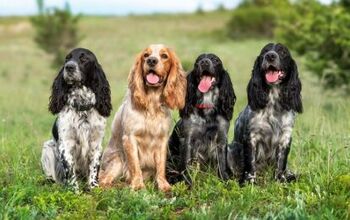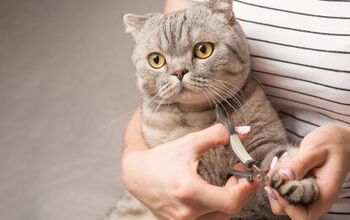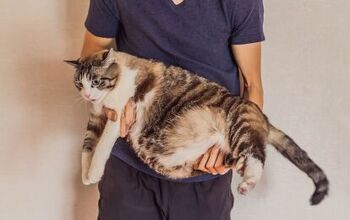Cockeranian


About Cockeranian
With their soulful eyes, silky coats and a playful personality, a Cockeranian is bound to charm you from the get-go. This designer dog breed hasn’t been around for too long and it has already conquered many hearts of dog owners, and with good reason. Not only that the unusual combination of a Pomeranian and Cocker Spaniel results in a remarkably beautiful pooch, these crossbreeds tend to flaunt a lovable character, too. Cockeranians are known to be loyal to their owners, devoted and loving, even to the extent of feeling anxious when separated from them.
Same as it is the case with all designer dog breeds, the Cockeranian will be a one-of-a-kind blend of their parents’ traits. For these adorable puppies, however, this means a vast variety of possibilities and differences. You see, the Pom and the Cocker Spaniel are two very different breeds, both when it comes to their appearance and size, and their personality. When these two breeds are crossed, litter can have puppies that all look different one from another, depending on which parent they favor more!
The unusual combination of a Pomeranian and Cocker Spaniel results in a remarkably beautiful pooch with a lovable character.
As a breed, Cockeranians have been around only for the last few years, when designer dog breeds became increasingly popular. That’s not to say that there haven’t been mixes of Pomeranians and Cocker Spaniels before that, it’s just that their mating wasn’t intentional and meant to create a whole new breed.
While there’s no sure fire way to claim where the first Cockeranian was born, the majority sources claim it was in the United States, same as most other hybrid and designer dog breeds. However, while it might be said that the Cockeranian is a recent breed, the breeds they originate from are certainly not new to the world of canines. Bred from German Spitzes to become a smaller version more suitable as a lap dog, the Pomeranian has been a beloved companion of nobles in the 18th century, his popularity still strong as ever. On the other hand, while the Pom was living it up at courts and villas, the Cocker Spaniel has been mucking about in the mud, as a hunting “assistant” that would flush out game for its owner, but his fate soon changed, once the beautiful silky-eared dog was bred to be more of a companion dog than a sporting one.
Currently, none of the designer dog breeds can boast of having a pedigree, as these crossbreed dogs are not recognized by the American Kennel Club, or any other major canine organization, for that matter. The reason for that is not something sinister- it’s that pedigrees are mostly reserved for show dogs, that have strict standards to which their looks have to adhere to.
With designer dogs, though, something like that is not possible: there’s simply too much room for direct offspring of two different purebred dogs to have unique looks. While pet parents might appreciate the individuality of Cockeranians and other mixed breeds, the lack of uniformity prevents them from obtaining an official pedigree. However, their parents might be show-quality dogs with their own pedigrees- which, in turn, can influence the price of the Cockeranian puppies quite a bit.
For dogs, a well-balanced diet is one of the key factors for their well being. Ensuring that your Cockeranian gets all the nutrients they need to stay healthy and happy will be one of the most important tasks for you as a pet parent! Fortunately, these designer dogs don’t have any peculiar tastes and will do well on a high-quality dry food for small dogs. You should take both their size and activity level into consideration when choosing their food- active dogs need more calorie-dense foods, but Cockeranians could become overweight if fed this kibble. As they are not finicky eaters and they are of small build, these four-legged gluttons can easily have issues with obesity, so don’t overindulge them with delicacies.
For Cockeranians, a combination of a well-balanced diet and exercise will ensure they don’t become overweight.
Every dog has its own individual character, but breed-specific behaviors and temperament play an important role in a dog’s character.
While the breeder will certainly strive for their puppies to have the most desirable traits of both parents and try to weed out the less appealing traits from the gene pool, there’s only so much that a person can do. In the case of the Cockeranians, those traits can be stubbornness, owing to the Pom in the mix, and excitability and energy inherited from the Cocker Spaniel. This can make them a bit difficult to train if you haven’t had experience with dogs before. It takes a bit of effort to teach these feisty puppies manners, but positive reinforcement training has proven to be the most efficient method. Once you figure out how to motivate your pet to do what you want them to- hint: yummy treats and encouraging voice will do the trick for most- there’s no saying what you can teach your smart little Cockeranian to do! Despite being a bit strong-willed, these dogs tend to be very smart, which makes for an easier training process.
Training and socialization are important for every dog, and for Cockeranian, they can prevent some major behavioral issues down the road. For instance, these devoted canines can develop separation anxiety due to the deep bond they form with owners, leading both to stress for the dog and the owner who has to put up with the pet’s destructive behavior. Thankfully, teaching your four-legged companion that independence is not a bad thing can do them a world of good. Make sure to take the necessary steps to prevent your Cockeranian from being overly clingy.
There might be no set standard for the designer dog breeds when it comes to their appearance, but you can guesstimate a lot of the crossbreed’s traits simply by looking at their parents. As for the Cockeranian, that’s where things get a bit more unpredictable.
The Pomeranian and Cocker Spaniel have quite a bit of weight and height difference between them, so their puppies can turn out to be very different one from another. Depending on which parent’s genes were more dominant with your Cockeranian puppy, you can expect them to weigh anywhere between 7 and 27 pounds- a significant difference, you’ll agree.
When it comes to the looks of designer dog breeds, all bets are off in most cases. But how about their behavior? What is the temperament of Cockeranian dogs? Not unlike the physical traits, the personality of your new pet will be a one-of-a-kind mix of the two parent breeds, Pomeranian and Cocker Spaniel, sprinkled with quirks unique to your pet only. Cockeranians are bred to be companion dogs, and their temperament certainly reflects it. These charming canines are quite affectionate, friendly, and devoted to their owner. To no one’s surprise, though, designer dog breeds don’t always inherit only the best of both worlds, but the less charming traits, as well. This means that, sometimes, your wonderful and adorable Cockeranian puppy can turn out to be a bit of a barking fiend like his Pom momma- or the yappy Cocker Spaniel, too!
However, with proper training and socialization, those potentially pesky behaviors and traits will be outshined by all other great things these pooches have to offer. The key is to understand what makes your pooch tick and what can you expect with their breed, so you can react on time if you notice any of the undesirable traits. Thankfully, with Cockeranians, there’s not much negative to be worried about!
There is a widespread belief that cross breeding purebred dogs can lead to their offspring having fewer health issues than the parents, as the gene pool is being “diluted” with the mix. Although this is often the case- after all, mixed breed dogs have a much better track record when it comes to health than purebred canines- it’s not to be taken as a guarantee that your pet will be free of all hereditary health problems.
Cockeranians are considered to be a fairly healthy breed, for all the reasons mentioned above, but there are still some breed-specific health issues that could be a concern. Depending on which parental breed your puppy takes up after, there are a few common problems you need to pay attention to. For instance, small breed dogs such as the Pomeranian are known to have dental health issues such as early teeth loss, so make sure to keep your pet’s oral hygiene up to standards to prevent this. Additionaly, Patent ductus arteriosus (PDA), a congenital heart issue common in Cocker Spaniels, can be a problem for your pooch, but it is very rare.
In addition to providing optimal care to your pet throughout their lifetime, you should make sure that the breeder you’re getting your Cockeranian from is a reliable and responsible one. Not only it will ensure your puppy comes from a humane environment, but it will lower the chances of them being born with various health issues due to irresponsible breeding.
Cockeranians as a breed haven’t been around long enough for pet experts to claim with certainty what their expected lifespan is. But, by looking at the average lifespan of both the Pomeranian and the Cocker Spaniel, it’s safe to estimate that their offspring will live between 12 and 16 years.
Considering that Cocker Spaniels were originally hunting dogs, it doesn’t come as too big of a surprise that Cockeranians have more energy than your average lapdog. Sure, your pooch will love snuggling on the couch with you, but they’ll also need you to take them to long walks, play fetch with them, and get fun toys to engage them. While they can thrive in an apartment setting, provided that their exercise requirements are met, Cockeranians would be ideally suited for living in a home with a fenced yard. They can be a bit mischievous and overly adventurous, so make sure to monitor them during playtime and on walks- you wouldn’t want your pooch to dash!
Even though they can be more high-maintenance than most small dogs in terms of exercise they need, Cockeranians are still at a moderate level of activity. About 60 minutes of daily exercise will help your pet stay in good shape and burn off any excess energy.
Due to their energy levels, Cockeranians would be ideally suited for living in a home with a fenced yard.
Cockeranians are recognized by American Canine Hybrid Club, Designer Dogs Kennel Club, Dog Registry of America, and International Designer Canine Registry.
The hair of both Pomeranian and the Cocker Spaniel is their pride: the first has a fluffy fur, and the second flaunts a silky, flowy hair. So, how does it bode for the Cockeranian when those two combine? Unless your Cockeranian puppy strongly favors one of its parents, they’ll have a double coat, with hair of medium length that gravitates towards the longer, sometimes curlier and at other times wavier.
Whichever the case, though, you can count on Cockeranians to be high maintenance when it comes to grooming. Their coat will need a lot of care and daily grooming to keep its beautiful sheen and velvety feel. And as for the palette, there are many possibilities. Cockeranians come in almost any color and color combination you can imagine, whether it’s a mono-colored coat or a mix of two or three colors.
The unusual mix of the cute Pomeranian with the beautiful Cocker Spaniel resulted in a truly wonderful companion dog. Cockeranian puppies will impress you both with their lovely looks and lovable character. As they have a bit more energy than most lap dogs, Cockeranians will appreciate either life in a home with a fenced yard or an owner that ensures they get enough exercise even though they live in a flat.
When properly socialized, Cockeranians make perfect family dogs, although they are a better match for those families who have older kids.
Photo credit: Photosite/Shutterstock

A proud mama to seven dogs and ten cats, Angela spends her days writing for her fellow pet parents and pampering her furballs, all of whom are rescues. When she's not gushing over her adorable cats or playing with her dogs, she can be found curled up with a good fantasy book.
More by Angela Vuckovic

























